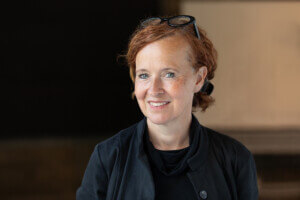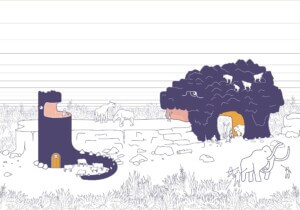Ambiguous Territory: Architecture, Landscape, and the Postnatural posits that ambiguity, rather than certainty, is what drives intellectual and aesthetic inquiry. The exhibition, which was first shown at the University of Michigan Taubman College of Architecture and Urban Planning, takes on the question of complex contemporary environmental and humanitarian issues, and the role that architects, landscape architects, and artists play in addressing them. Organized and curated by Kathy Velikov, Chris Perry, Cathryn Dwyre, and David Salomon, the show originally ran in September and October, but will also be on display in New York in the coming year.
Divided into three categories, Ambiguous Territory brings together an exhaustive list of over 40 young practices working along the blurry edges of the architecture field. The categories include “I. Above: The Atmospheric,” “II. On: The Biologic,” and “III. Below: The Geologic.” In each case, contributors were asked to show work that specifically engaged with the “post-natural era.” This includes addressing climate change, concepts of the Anthropocene, and artificial and altered ecologies. As the show’s title hints, these categories are understood in decidedly ambiguous terms. The work in each engages with much more than the physical or scientific connotations implied by the category titles and many projects span multiple, if not all the groupings.
This intermixing of ideas is at the core of the show, which hopes to engage with the contemporary sensibility of bringing together “unlike things into singular forms or images.” As such, visitors to the show will find everything from remote sensors, robots, and satellite imagery, to plant languages, rock piles and point clouds. Considering the wide range of often invisible, and sometimes ephemeral, forces and concepts, contributions to the show dabble in an equally wide range of representational and annotative techniques. In many cases, drawings and image-making techniques are borrowed from a number of fields and pushed beyond their conventions to visualize concepts that are often hardly visible. The three-dimensional objects in the show take a similar approach to fabrication, producing a number of uncanny, if not unsettling forms which defy typical descriptions.
In the “Above” category the work of contributors such as Sean Lally, Mark Nystrom, and Lateral Office & LCLA, looks at the movement and capturing of atmospheric conditions, such as wind and heat, are address. Other offices, such as NaJa & deOstos and Kallipoliti & Theodoridis, look more directly at the impact and possibilities of architecture and its relationship with the atmosphere.
Offices working in the “On” category explore biological conditions that are either affected by or which affect humans. Works by firms such as The Bittertang Farm, Future Cities Lab, and pneumastudio each provide spatial constructs for species, living or extinct, other than humans. On the other hand, Terreform ONE’s In Vitro Meat Habitat and Office for Political Innovation’s Landscape Condenser mediate the relationship of humans to constructed biological systems.
The “Below” category is filled with practices exploring the more substantial aspects of the show through material and geology. Firms Smout Allen, The Open Workshop, and Design Earth each look to the future of the subterranean, while Formlessfinder, Lisa Hirmer, and Alexander Robinson examine physical material properties through crushing, piling, and vibrating.
The first showing of Ambiguous Territory was accompanied by a symposium, which included discussions by many of the show’s participants as well as keynote addresses by Liam Young and David Gissen. While the show closed in Michigan in October, it will be remounted at the Pratt Manhattan Gallery, New York, from December 2018 through January 2019.










